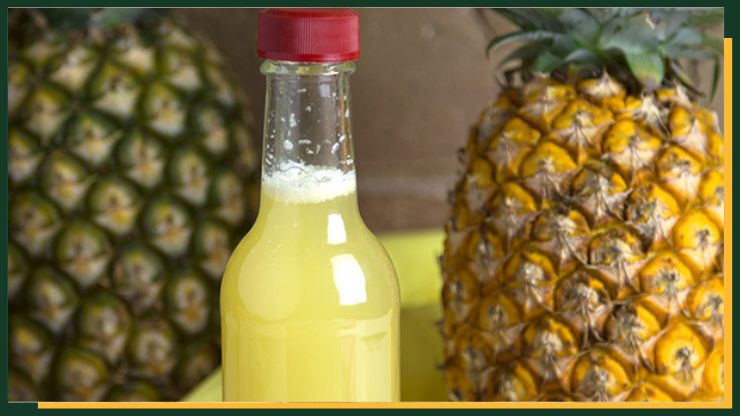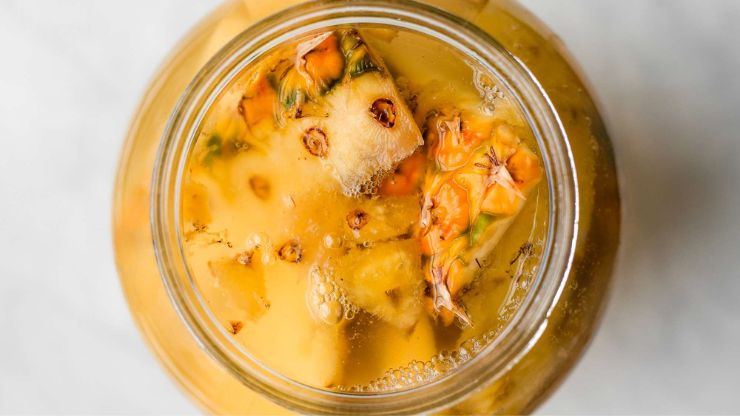Raw Pineapple Vinegar is a delightful tropical condiment that can elevate your culinary creations. This simple, homemade vinegar infuses the sweet, tangy essence of ripe pineapples into your dishes, dressings, marinades, and beverages.
With just a few ingredients and minimal effort, you can create a versatile and flavorful addition to your kitchen repertoire. This recipe will guide you through the process of turning ripe pineapples into a delightful vinegar, providing a burst of exotic flavor that can transform your cooking.
Whether you’re a seasoned chef or a novice in the kitchen, making raw pineapple vinegar is an enjoyable and rewarding endeavor. So, let’s embark on this journey to capture the essence of the tropics in a bottle with our easy-to-follow recipe.
Table of Contents
ToggleIngredients for Raw Pineapple Vinegar
- Ripe Pineapple: Choose a ripe and sweet pineapple to ensure the best flavor in your vinegar. The quantity of pineapple you use can vary based on how much vinegar you want to make.
- Sugar: Granulated white sugar is commonly used to kickstart the fermentation process. You’ll need approximately 1-2 tablespoons of sugar per cup of pineapple. Adjust the amount based on your taste preferences and the sweetness of the pineapple.
- Water: Use clean, chlorine-free water for the fermentation process. The amount of water required will depend on the quantity of pineapple you use.
Also, Read – Sourdough English Muffins Recipe
Equipment for Making Raw Pineapple Vinegar
- Glass Jar with a Wide Mouth: Choose a clean glass jar with a wide mouth to hold the pineapple mixture. The jar should be large enough to accommodate the pineapple chunks and leave some headspace.
- Cheesecloth or Coffee Filter: You’ll need a piece of cheesecloth or a coffee filter to cover the mouth of the glass jar. This allows air to circulate while keeping out contaminants during fermentation.
- Rubber Band or String: A rubber band or a piece of string is used to secure the cheesecloth or coffee filter over the jar’s mouth.
- Wooden Spoon: You’ll use a wooden spoon to mash the pineapple and sugar together to create a pulpy mixture.
- Fine-Mesh Strainer: After the fermentation period, you’ll need a fine-mesh strainer to separate the liquid from the pineapple solids.
- Clean Glass Bottle or Jar with a Lid: Once you’ve strained the vinegar, transfer it to a clean glass bottle or jar with a tight-sealing lid for storage.
These basic pieces of equipment are essential for making raw pineapple vinegar, and they’ll help ensure a successful and hygienic fermentation process.
Raw Pineapple Vinegar Recipe

Clean the Container
Clean the container with hot, soapy water to remove any dirt and residue. Rinse thoroughly to eliminate soap residue. Sterilize by boiling it for a few minutes, or use a bleach solution (1 tablespoon of bleach per gallon of water) and soak for a few minutes.
Rinse with clean water. Alternatively, bake the container at 225°F (107°C) for 30 minutes, then let it cool before use. Ensure it’s completely dry before using it for your pineapple vinegar.
Prepare the Pineapple
Wash and peel a ripe pineapple. Cut it into small pieces, including the core and scraps. Place the pineapple pieces in a clean, sterilized glass or ceramic container. Lightly mash them with a wooden spoon to release some juice.
Create a Pineapple Mash
To create a pineapple mash for making raw pineapple vinegar, start by washing and peeling a ripe pineapple. Cut the pineapple into small pieces, including the core and scraps. Place these pineapple pieces into a clean, sterilized glass or ceramic container.
Using a wooden spoon or a muddler, gently press and mash the pineapple pieces. The goal is to release the juice and make it easier for the fermentation process. You don’t need to completely pulverize the pineapple; just lightly mashing it will do.
This mashed pineapple will serve as the base for your vinegar, providing the natural sugars needed for fermentation.
Make a Sugar Solution
To make a sugar solution for raw pineapple vinegar, take a separate clean container. In this container, mix 1 cup of granulated sugar with 1 cup of water. Stir thoroughly until the sugar is completely dissolved.
This sugar solution will provide the necessary sugar for the fermentation process. The sweetness of the sugar is crucial, as it will be converted into alcohol and then into acetic acid by the fermentation process.
Once the sugar is fully dissolved, you can proceed to pour this solution over the mashed pineapple in the primary fermentation container, kickstarting the vinegar-making process. Stir to ensure the sugar solution is well-distributed among the pineapple.
Don't just scroll, subscribe!
BuzzTrail's unique web-stories are the cure for boredom you've been waiting for.
Also, Read – Fermented Foods for Improved Digestion
Add the Sugar Solution
After you’ve mashed the pineapple in a clean container, it’s time to add the sugar solution. In a separate container, mix 1 cup of granulated sugar with 1 cup of water, stirring until the sugar is completely dissolved. This sweet sugar solution is essential for the fermentation process, as it will be converted into alcohol and then acetic acid, turning the pineapple into vinegar.
Pour the sugar solution over the mashed pineapple in the primary fermentation container. Use a utensil to mix and ensure the sugar solution is evenly distributed among the mashed pineapple. This step initiates the fermentation process and provides the necessary sugars for the microbes to work on, eventually transforming the mixture into vinegar.
Cover with a Cloth
After adding the sugar solution to the mashed pineapple, cover the container with a clean cloth or a paper towel. Secure the cloth in place using a rubber band or string. This covering allows air to circulate while keeping out dust and debris.
It’s essential for the fermentation process, as it provides a breathable barrier that helps beneficial microorganisms develop, turning the pineapple and sugar mixture into vinegar. Place the container in a dark, cool location (around 70-80°F or 21-27°C) for about 2-4 weeks, stirring occasionally.
Let It Ferment
Allow the covered container of pineapple and sugar solution to ferment in a dark, cool place, ideally around 70-80°F (21-27°C). This fermentation process typically takes 2-4 weeks. During this time, beneficial microorganisms will work on converting the sugars into alcohol and then into acetic acid, which is what makes vinegar.
Remember to stir the mixture every few days to help with the fermentation process. You’ll notice bubbling and a sour smell as the vinegar develops. Taste it periodically to determine when it reaches your desired level of acidity.
Check for Fermentation
Check for fermentation signs by observing the container after 2-4 weeks. Look for bubbling and a sour, vinegar-like smell, indicating the fermentation process is underway. Taste a small sample to check the acidity. If it has reached your desired level of tanginess, the vinegar is ready.
If not, let it ferment a bit longer. Patience is key; the longer you ferment, the stronger the vinegar. Once it reaches your preferred taste, proceed to strain and bottle it for storage.
Strain and Bottle
To strain and bottle your pineapple vinegar, use a fine-mesh strainer or cheesecloth over a clean, sterilized bottle or jar. Pour the fermented mixture through the strainer to separate the liquid from any remaining pineapple solids.
Discard the solids. Seal the bottle or jar with a lid and store it in the refrigerator or a cool, dark place. Your raw pineapple vinegar is now ready for use in recipes, dressings, or as a flavorful condiment.
Store the Vinegar
Store your raw pineapple vinegar in a sealed bottle or jar. Keep it in the refrigerator or a cool, dark place. The vinegar will continue to develop its flavor over time. Ensure the container is tightly sealed to prevent contamination and to maintain the vinegar’s quality. It can be stored for several months, and the flavors may mature with time, giving you a richer and more complex vinegar for your culinary creations.
Conclusion
Creating raw pineapple vinegar is a rewarding and flavorful adventure in your own kitchen. With minimal effort and just a few ingredients, you can capture the essence of the tropics in a bottle. This versatile condiment adds a tangy, tropical twist to your culinary creations, from salad dressings to marinades.
Whether you’re an experienced chef or a culinary novice, this homemade vinegar offers a delightful touch to your dishes. So, get started on your journey to infuse your recipes with the exotic flavor of pineapple and elevate your cooking to new heights.
FAQs
Can I use canned pineapple for this recipe?
Can I use canned pineapple for this recipe?
While fresh pineapple is recommended, you can use canned pineapple if fresh is not available. Just ensure it’s in its natural juice without added preservatives.
How long does the fermentation process take?
How long does the fermentation process take?
The fermentation typically takes around 2-3 weeks, but the exact time can vary based on factors like temperature and the natural yeast in your environment.
Can I adjust the sweetness of the vinegar?
Can I adjust the sweetness of the vinegar?
Yes, you can adjust the sweetness by adding more or less sugar to the pineapple mixture during the initial preparation.

